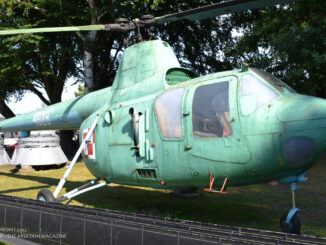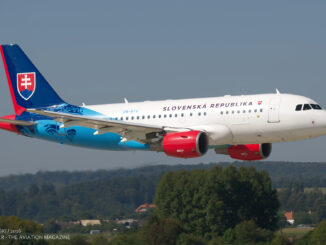 North American P-51D-25NT Mustang (c/n 124-48293, N151W ´Excalibur´) taxiing for take-off to perform flying display during Aerofestival 2015 at Poznań-Ławica airport, Poznań (June 2015).
North American P-51D-25NT Mustang (c/n 124-48293, N151W ´Excalibur´) taxiing for take-off to perform flying display during Aerofestival 2015 at Poznań-Ławica airport, Poznań (June 2015).
The example of the most iconic US fighter of World War II – which we present today within our Photo of the Week series – was built in 1945, but already after the war. The aeroplane was produced by North American Aircraft in Dallas, Texas as P-51D-25-NT with c/n 124-48293 and s/n 45-11540. Shortly after leaving the factory, the Mustang was handed over to the United States Army Air Force. However, the aeroplane was not entered into active service, but instead was put into storage.
On 18th September 1947, with the establishment of the United States Air Force as a separate branch of the United States Armed Forces, the 45-11540 was transferred to the USAF, but still remaining in storage. Next year, in accordance with the then-introduced change in designations of the US fighter aircraft from P (Pursuit) to F (Fighter), the aircraft became identified as F-51D.
Eventually, like many surplus military aircraft and equipment in the post-war years, the F-51D found its way into private ownership, bought by James W. Steverson of Littleton, Colorado in 1966, receiving civil registration N5162V.
However, three years later, on 17th February 1966, the aircraft suffered heavy damage as a result of an accident at Municipal Airport in Columbia, Colorado. Shortly after take-off, due to unfavourable wind conditions, the Mustang stalled or mushed during the initial climb and then crashed. Luckily, there were no fatalities.
Only in the mid-1970s the aircraft was fortunately rebuilt, with the restoration carried out in Chino and Van Nuys, in California. In 1978, the 45-11540 was bought by Dennis Schoenfelder from Santa Barbara, California, keeping its registration number of N5162V.
Its registration changed – to N151W, which it still has today – only in 1983 when the Mustang was sold to another owner, Joe G. Mabee from Midland, Texas. He flew the 45-11540 until 1992.
In 1993, the fighter was sold once again, this time to James A. Michaels of Oconomowoc, Wisconsin, who owned the aeroplane until 1997. It was at this time that this particular aircraft was given its first official nickname – ‘Queen B.’, painted on both sides of the nose just below the exhausts. Image of the said ‘Queen B.’, resembling a half-woman/half-bee, was also painted on the port side of the fuselage just below the pilot’s cabin.
The years 1996 and 1997 were the particularly interesting period in the history of the 45-11540. During this time, the ‘Queen B.’, with starting number 12, raced in the Unlimited Class of the well-known National Championship Air Races in Reno, Nevada.
In the races held between 9th and 15th September 1996, the ‘Queen B.’, with its owner James Michaels as primary pilot, first finished qualifying in 16th position, achieving an average speed of 568.59 kph (353.304 mph). Then, the aircraft finished 7th in Heat 1B with an average speed of 499.05 kph (310.093 mph). In Heat 2C it earned a very high 2nd place with a measured average speed of 535.79 kph (332.924 mph). Finally, in the Silver Race, the ‘Queen B.’ achieved an average speed of 555.62 kph (345.249 mph), eventually taking 6th position.
From 8th to 14th September 1997, the aircraft competed in the next edition of the air races held in Reno, once again with Michaels as primary pilot. This time the ‘Queen B.’ qualified in 15th position by achieving an average speed of 600.64 kph (373.220 mph). In the subsequent sessions of the race, the aircraft again continued to climb up the leader board. In Heat 1B, the fighter took 5th position with a recorded average speed of 517.02 kph (321.260 mph). In Heat 2C, achieving an average speed of 550.17 kph (341.857 mph), it placed 4th. In Heat 3C the aeroplane took 3rd place, flying at an average speed of 600.35 kph (373.040 mph). In the Silver Race, the ‘Queen B.’ took the strong 5th position after the flight at an average speed of 591.60 kph (367.603 mph).
On 30th September 1998, the warbird was sold to James M. Read from Chesterton, Indiana, keeping the previous c/r N151W. Owned by Read, the 45-11540 received new nickname – ‘Excalibur’. It was soon written with yellow letters on both sides of the warbird’s nose just below the exhausts along with image of the legendary sword. The PE-R side-code was also added on the fuselage of the aircraft. Since 2004, the ‘Excalibur’ was based at Indiana Aviation Museum located at the Porter County Regional Airport in Valparaiso, Indiana.
In May of 2010, the 45-11540 was advertised for sale and in August of 2011 found its way to Europe. The ´Excalibur´ was bought by Petr Turek of Český Letecký Ráj (Czech Aviation Paradise) and since then, the aircraft is based at Mnichovo Hradiště airport in Hoškovice, Central Bohemian region of Czech Republic.
The colours of the Mustang 45-11540 have remained unchanged over the years. Its – mostly unpainted – polished fuselage, blue-painted nose, characteristic invasion stripes on the underside of the wings and fuselage and checkerboard painted rudder, as well as the side-code PE-R, all together refer to the 328th th Squadron, 352nd Fighter Group of 8th Air Force USAAF, which flew the P-51s during World War II.
During its long history record as privately owned warbird, that Mustang – besides the aforementioned participation in the Reno air races – attended many air shows and other aviation-related events in the United States and Europe.
Nowadays, it is still a regular attendee of air shows across the Old Continent. In June of 2015 the P-51D ‘Excalibur’ visited Poland, taking part in the Aerofestival organised at Poznań-Ławica airport. It was a perfect opportunity to introduce the iconic silhouette and legendary whistle-sound of the ‘Cadillac of the Skies’ to Polish spectators.



